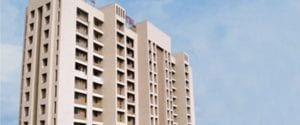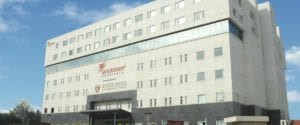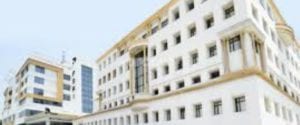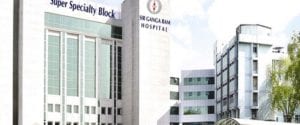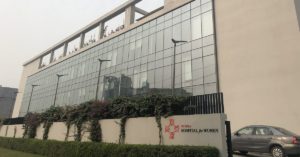Best Doctors in India for Septoplasty
Best Hospitals in India for Septoplasty
S L Raheja Hospital, Mahim, Mumbai
- City: Mumbai, India
Hospital Highlights:
- SL Raheja hospital is a 140-bed multi-specialty tertiary care hospital that is being managed by Fortis Healthcare Ltd.
- The hospital is a benchmark in healthcare and medical facilities in the neighborhood of Mahim & the western suburbs.
- L.Raheja Hospital, Mahim has one of the most effective ICU and Casualty care services.
- The hospital provides specialty medical services in Cardiology, Oncology, Neurology, Orthopedics, Mother & Child Care, and in Diabetes.
Wockhardt Hospitals, Mumbai
- City: Mumbai, India
Hospital Highlights:
- Wockhardt Hospitals were established in the year 1973, originally called First Hospitals and Heart Institute.
- Wockhardt Hospitals are super specialty health care networks in India, nurtured by Wockhardt Ltd, India’s 5th largest Pharmaceutical and Healthcare company.
- Wockhardt Hospitals is associated with Partners Harvard Medical International, an international arm of Harvard Medical School, USA.
- Wockhardt Heart Hospital performed India’s first endoscopic heart surgery.
- The hospital has a state-of-the-art infrastructure equipped with the latest technologies and modern equipment.
- It has special Centers of Excellence dedicated to the major specialties to provide hassle-free and high-quality clinical care.
Pushpawati Singhania Hospital & Research Institute, New Delhi
- City: New Delhi, India
Hospital Highlights:
- Established in 1996, Pushpawati Singhania Research Institute is one of the top hospitals in the NCR region, as well as one of the top facilities in India for gastroenterology. The hospital is one of South Asia’s first institutes in medical and surgical treatment for diseases related to digestion.
- The hospital is equipped with state-of-the art facilities coupled with the latest equipment as well as renowned consultants from various parts of India as well as other parts of the world.
W Pratiksha Hospital, Gurgaon
- City: Gurugram, India
Hospital Highlights:
- W Pratiksha Hospital, Gurugram, is one of the best hospitals in the NCR region. It is also a top hospital in India for IVF. Since its inception, the hospital has performed over 5500 successful IVFs. The hospital also specializes in gynecology.
- With over 20 years of experience in providing quality healthcare, the hospital is known as one of the most trusted and valued health providers in India.
- Equipped with world-class medical facilities and advanced technology, the hospital’s doctors and clinicians also have a track record of delivering excellent results. The hospital is also known for focusing on preventive well-being as much as on curative treatment.
- The hospital has earned the trust of its patients, by providing the best available treatments at affordable costs.
Narayana Superspeciality Hospital, Gurugram
- City: Gurugram, India
Hospital Highlights:
- Situated near DLF Cyber City, Gurugram, Narayana Superspecialty Hospital is one of the top medical facilities in the Delhi NCR region, catering to the needs of the people. Known for its commitment to quality medical care and patient service, the hospital is a state-of-the-art facility with planned and well-equipped sections, which includes a spacious OPD area as well as comfortable patient rooms.
- It is the closest super-specialty hospital from Indira Gandhi International Airport towards Gurugram, and also the nearest super specialty hospital from DLF Cyber City. It is also close to major residential areas in Gurugram.
- It is part of the renowned Narayana Health Group. Established in 2000, by Dr. Devi Shetty, a renowned cardiac surgeon, it has grown to be one fo India’s leading healthcare groups.
Sir Ganga Ram Hospital, New Delhi
- City: New Delhi, India
Hospital Highlights:
- Sir Ganga Ram Hospital, New Delhi is known to provide the latest medical procedures with the latest technology in all of its units.
- The hospital has a team of reputed doctors, nurses, and healthcare professionals that ensure that patients receive quality care at affordable costs.
- Staffed with a team of highly qualified doctors, dedicated nurses, and paramedical and non-medical staff, the hospital aims to lead in healthcare delivery, medical education, training, and research.
- As per the vision of the founder, the hospital also provides free treatment to the economically weaker sections of society.
- Sir Ganga Ram Hospital also provides training to young doctors under the Diplomate in National Board(DNB) program. The DNB program at the hospital was started in 1984 and it is known for currently running the maximum number of DNB specialties in the country. It also has the distinction of having the first bone bank in India.
CK Birla Hospital, Gurugram
- City: Gurugram, India
Hospital Highlights:
- The CK Birla Hospital in Gurugram is a NABH-accredited multi-specialty hospital.
- The hospital strives to increase the quality of healthcare by focusing on UK NHS nurse and midwife training requirements. Policies and practices derived from the National Institute for Health and Treatment Excellence (NICE) recommendations in the United Kingdom ensuring that a strong focus on safety, high-quality clinical care, and sanitation is maintained.
- The hospital’s cutting-edge technology and facilities allow for real-time communication and seamless collaboration among caregivers, ensuring accuracy and the best possible results. Those with foreign experience and accreditations make up part of the hospital’s team of clinicians.
KIMS Hospital, Hyderabad
- City: Hyderabad, India
Hospital Highlights:
- KIMS Hospital (a brand name of Krishna Institute of Medical Sciences) is one of the largest and best multi-speciality hospitals in Hyderabad. The hospital provides various treatments to an enormous number of patients.
- The hospital has a capacity of more than 3000 beds. KIMS Hospitals offers different healthcare services in more than 25 specialities and super specialities.
- The hospital is equipped with modern medical equipment and technology. It has robotic equipment to provide minimal invasive techniques for patients.
- The hospital is aimed at providing world-class healthcare facilities and services at an affordable cost for patients.
- The various specialities and departments of the hospital include neurosciences, gastroenterology & hepatology, robotic science, reproductive sciences, dental science, oncological sciences, organ transplantation, heart and lung transplantation and mother and child care.
Fortis Hospital, Shalimar Bagh
- City: New Delhi, India
Hospital Highlights:
- Fortis Hospital in Shalimar Bagh is a multi-super specialty hospital that strives to provide world-class patient care by leaving no stone unturned.
- Fortis, Shalimar Bagh, with 262 beds and a 7.34-acre footprint, provides the best level of medical care through its team of doctors, nurses, technicians, and management professionals.
Reliance Hospital, Mumbai
- City: Mumbai, India
Hospital Highlights:
- Reliance Hospital is one of the best super-specialty care hospitals in Navi Mumbai.
- The main purpose of this hospital is to become a trustworthy place for the best health and hope for society. The hospital is well connected to the suburbs of Mumbai and Navi Mumbai.
- The hospital has various specialty departments, viz., Accident & Emergency, Anesthesiology, Dental Services, Dermatology, Diabetology, Dietetics Nutrition, Endocrinology, ENT, Gastroenterology, General Surgery, Gynaecology And Obstetrics, Hepato Pancreato Biliary Surgery, Infectious Disease, Internal Medicine, Interventional Radiology, Laboratory Medicine, Minimal Access Laparoscopic Surgery, Nephrology, Neurosciences, Opthalmology, Orthopaedics, Paediatrics, Pain Management Palliative Care, Physical Medicine Rehabilitation, Plastic And Reconstructive Surgery, Psychiatry, Pulmonary Medicine, Radiology, Rheumatology, Transplant, Urology Andrology, Vascular Surgery
Septoplasty
Septoplasty is a surgical procedure done to straighten the septum or correct deviation in the septum. A septum is a wall of cartilage & bone that divides the two nostrils of your nose. The septum is called deviated when it is crooked. People having a deviated septum may experience difficulty in breathing through their nose. This increases the risk of infections in the sinus as there is poor drainage. Although some people are born with a deviated nasal septum, an injury to the nose may also cause the septum to deviate.
People having a deviated nasal septum will have one of the two nasal passages smaller than the other one that causes difficulty in breathing. Nose bleeding and facial pain are symptoms of a deviated nasal septum. During the Septoplasty procedure, your doctor will reposition your nasal septum to the middle of your nose. For this, he or she will cut & remove the parts of the nasal septum and reinsert them into a proper position. Upon healing, you will be able to breathe through your nose easily. Your surgeon will also discuss the possibilities and expected results in your case.
Why should I opt for Septoplasty?
Many people have crooked septum. However, in severe cases, there might be a blockage on one side of the nose due to a deviated septum that reduces airflow. This may cause difficulty in breathing through your nose from either one or both sides. The Septoplasty procedure can help to straighten your septum by trimming, repositioning, and replacing the bone and/or the cartilage. You may think of going for the Septoplasty procedure for fixing your deviated septum if you are experiencing symptoms like difficulty in breathing through the nose and it is affecting your quality of life.
Preparing for the surgery
You may need to stop taking specific medications for two weeks before the surgery. These medications may include blood thinners and ibuprofen or aspirin. Your doctor will instruct you on this to reduce the risk of excessive bleeding during and after the Septoplasty surgery. If you have an allergy to some medications or if you have problems like excessive bleeding, you must inform your doctor about the same. People undergo this surgery usually under a local anesthetic agent that numbs the surgery site and prevents pain. However, some people opt for the surgery under general anesthesia that makes them fall asleep at the time of the surgery.
You need to start fasting from the night before the surgery if you will be having the surgery under general anesthesia. This is because it prevents choking if you have nausea or vomiting due to the anesthesia during the surgery. You may ask your doctor to take a photo and compare it with another photo to be taken after the procedure. This will help you notice the changes in your nose.
What to expect?
Your surgeon will make incisions in your nose, especially a small incision between your nostrils. It is necessary to make cuts or incisions in the bone of your nose for repositioning them if your nasal bones are crooked and push your nasal septum to 1 side. Your surgeon might use spreader grafts that are small & reinforcing strips of cartilage. They help to correct a deviated nasal septum when you have a problem at the bridge of your nose. In some cases, these grafts are necessary for straightening the septum effectively.
Before the procedure
Your doctor may administer local or general anesthesia in your body. The complexity of your surgery and the choices of you & your doctor will help in determining the type of anesthesia for you. The local anesthesia numbs the area only up to the nose. Your doctor will inject it into the nasal tissues. However, if your doctor is administering general anesthesia, he or she will use an IV line for the same and you will be temporarily unconscious with effects on your entire body.
During the procedure
Your surgeon will make incisions and reposition the nasal septum. He or she might cut several parts of your septum for the same. Next, your doctor will use absorbable sutures to close the incisions. He or she will insert soft silicone splints in each of your nostrils for supporting the nasal septum. He or she will use a bandage-like material for packing your nose to prevent bleeding after the completion of the surgery.
After the procedure
The nurse will move you to a recovery room after the surgery where the team can watch & monitor your condition for any complications. You will need someone to take you home and avoid driving for a few weeks after the surgery. You may need to elevate your head during sleep, avoid blowing your nose, and avoid strenuous activities for a month so that there is no bleeding.
Results
Risks of the procedure
Septoplasty procedure too has some risks like infection, bleeding, or adverse reaction to anesthesia. However, there are some other associated risks also that may be:
- Excessive bleeding
- Scarring
- Nasal obstruction and other symptoms
- A hole in your nasal septum
- Numbness in your upper gums or nose, temporarily
- Alterations in nose shape
- Clots of blood in your nasal space that requires drainage.
You may reduce these risks by keeping your nose clean and frequently washing the hands. One may need multiple surgeries for treating some or all of these risks. If the results of the Septoplasty procedure are below your expectations, you may opt for additional surgery for the same. You may talk to your doctor surgeon for discussing your case and the associated risks if you undergo the surgery.

